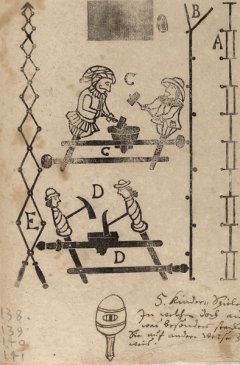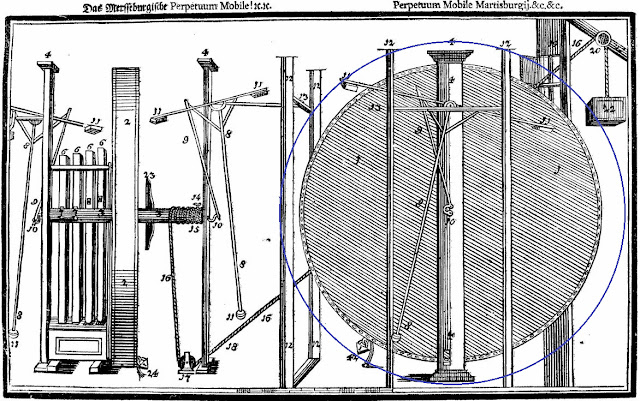When Johann Bessler finally constructed a working perpetual motion machine he was hesitant about labelling it as such. He stated that the weights within the machine were the actual perpetual motion device, which at first sight looks unlikely, or perhaps there is ap paucity of information. But he knew from more than ten years of trying to build the machine, that it was the heaviness of the weights which provided the energy to turn the wheel. I should add at this point, everything Bessler wrote was important even if it looked like a throw away comment. There are always extra meanings to be found within his comments.
The word ‘heaviness’ has the same meaning as ‘ponderance’, a word often used by Bessler - and Sir Isaac Newton used the word ‘gravity’ which translates literally from the Latin, in which he wrote, to ‘weight‘ ‘heaviness’ and ‘ponderance’. Given that perpetual motion was defined in those days, and still is today, as being an isolated system, having no access to any external energy source, one can understand Bessler’s reluctance to describe his machine as a perpetual motion device. He wrote that ‘heaviness’ surrounded his world and permeated everything in it and therefore could not be excluded from both within and without his machine, in which case either it wasn’t a true perpetual motion machine, or the definition was wrong to exclude all external energy sources.
But he had little choice if he wished to gain the attention of the rich to whom he wished to sell his wheel. He called it a perpetual motion machine but explained why it might not be correct to label it thus. He said that no device could ever be perpetually in motion because of wear and tear, or accidental breakdown. He often referred to it as the ‘so-called perpetual motion’. He was a clever man who had a good understanding of his machine and how and why it worked.
Given Bessler’s understanding of his machine and the definition of perpetual motion, it’s amazing that numerous examples describing perpetual motion exist on the internet, thus,
“ Perpetual motion is the motion of bodies that continues forever. A perpetual motion machine is a hypothetical machine that can do work infinitely without an energy source. This kind of machine is impossible, as it would violate the first or second law of thermodynamics.”
So, they all state the obvious, that without an energy source such machines are impossible. They ignore Bessler’s strong claim that gravity - an external source - supplied the energy. Countless times I’ve been made aware that gravity is not an energy source, and I accept it as a fact, but - and I’m going out on a limb here - Bessler attributed his energy source to the weights, the weights fell and through some ingenious mechanism, caused the wheel to rotate. Gravity made the weights fall. So gravity did work, and how much work it did can be calculated through a simple formula. So regardless of the fact that gravity is a conservative force, it did do work. Gravity is described as a force. Force is defined as the capability to do work.
The only possible reason for not accepting that gravity can be a source of free energy, is the fact that no one ever invented a way to return the fallen weights back to their pre-fall position....until Bessler did. It was never impossible, just that no one knew how to do it.
JC
The word ‘heaviness’ has the same meaning as ‘ponderance’, a word often used by Bessler - and Sir Isaac Newton used the word ‘gravity’ which translates literally from the Latin, in which he wrote, to ‘weight‘ ‘heaviness’ and ‘ponderance’. Given that perpetual motion was defined in those days, and still is today, as being an isolated system, having no access to any external energy source, one can understand Bessler’s reluctance to describe his machine as a perpetual motion device. He wrote that ‘heaviness’ surrounded his world and permeated everything in it and therefore could not be excluded from both within and without his machine, in which case either it wasn’t a true perpetual motion machine, or the definition was wrong to exclude all external energy sources.
But he had little choice if he wished to gain the attention of the rich to whom he wished to sell his wheel. He called it a perpetual motion machine but explained why it might not be correct to label it thus. He said that no device could ever be perpetually in motion because of wear and tear, or accidental breakdown. He often referred to it as the ‘so-called perpetual motion’. He was a clever man who had a good understanding of his machine and how and why it worked.
Given Bessler’s understanding of his machine and the definition of perpetual motion, it’s amazing that numerous examples describing perpetual motion exist on the internet, thus,
“ Perpetual motion is the motion of bodies that continues forever. A perpetual motion machine is a hypothetical machine that can do work infinitely without an energy source. This kind of machine is impossible, as it would violate the first or second law of thermodynamics.”
So, they all state the obvious, that without an energy source such machines are impossible. They ignore Bessler’s strong claim that gravity - an external source - supplied the energy. Countless times I’ve been made aware that gravity is not an energy source, and I accept it as a fact, but - and I’m going out on a limb here - Bessler attributed his energy source to the weights, the weights fell and through some ingenious mechanism, caused the wheel to rotate. Gravity made the weights fall. So gravity did work, and how much work it did can be calculated through a simple formula. So regardless of the fact that gravity is a conservative force, it did do work. Gravity is described as a force. Force is defined as the capability to do work.
The only possible reason for not accepting that gravity can be a source of free energy, is the fact that no one ever invented a way to return the fallen weights back to their pre-fall position....until Bessler did. It was never impossible, just that no one knew how to do it.
JC










